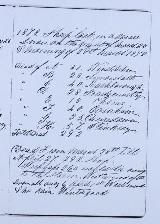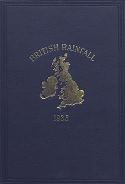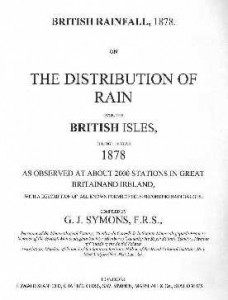On March 29th 1878, Exmoor Head Shepherd Robert Tait Little (RTL) recorded in his diary: “Great Snow Storm. Lost 290 Sheep after a fine winter.”
By the end of April, RTL is clearly in a better position to assess the damage and another page from his diary, shown below, details the losses from the great snow storm of 1878.

Archive Ref: 3394/HOC264
1878: sheep lost in a severe snow on the night of March 28th and morning of 29th March 1878.
Dead
A 21 Winstitchen
B 28 Simonsbath
C 40 Larkborough
D 28 Badgeworthy
E 13 Chains (Hoar Oak)
F 40 Cornham
G 55 Duredown
H 57 Pinkery
Total Dead 292
Dead from March 28th till April 27th 292 Sheep. Perhaps 260 would die owing to the storm. Weather good after. Snow all away by April 1st West wind and no rain. Winter good.
Note: The letters A, B, C etc relate to the code number Robert Tait Little had given each of the farms and herdings. Hoar Oak was also known as the Chains herding and was Code E. They lost 13 sheep at Hoar Oak in the bad weather. Elsewhere in the diaries RTL uses the just the code letters to record information about the farms – a sensible timesaving approach to record keeping avoiding writing out the long farm names.
This collection of information about how many sheep had died at the various Exmoor herdings would have been made over the two or three weeks following the dreadful storm of March 28th and 29th, 878. Although Robert Tait Little says the snow was ‘all away’ by April 1st it is likely that it would still have been difficult for him to get out to some of the most remote farms or for the shepherds to get to a village to report their losses from the great storm. The heavy snow and large drifts would have remained longer up on the high moor making it difficult to get about and, as is often the case in such conditions, the sheep can get buried in snow drifts only to emerge, still alive, some days or even weeks later.
As a consequence it is not until April 27th, nearly a month later, that RTL appears to be in a position to make a full tally of lost sheep over those 4 weeks and to write it up in his stock diary. It is interesting that he makes a judgement about how many he thought actually died from the storm – he says perhaps 260 would die owing to the storm. The reason for the other 30 deaths – other than usual winter losses one supposes – is not stated. It does seem, from RTL’s notes, that the weather before and after the great storm had been not too bad. No doubt a bitter irony.
Research by The Friends has shown that this snow storm was worthy of being recorded and mentioned in the annual Symons British Rainfall Records of 1878. This book contains an overview of weather throughout the British Isles on a month by month basis as well as recording rainfall including snow throughout the year.


Clearly this weather event was of sufficient importance and of such a devastating effect as to feature so strongly in both Robert Tait Little’s Diaries and in Symon’s British Rainfall book.
What was happening at Hoar Oak Cottage during the great storm of March 1878? At this date Hoar Oak Cottage was occupied by William and Fanny Davidson. They had several children, a son born at Hoar Oak in 1872, a daughter in 1873, another son in 1877 and another daughter in 1879. Later in 1879 the family had moved on to Winstitchen and so during the Great Storm of 1878 it is very likely that the Davidson would be at Hoar Oak Cottage with 2 small children and a tiny baby. RTL’s diary records that 13 sheep were lost to the great storm from The Chains herding run by William Davidson. Was the experience of the great storm one of the factors which resulted in Shepherd Davidson taking on the Winstitchen herding? The farmhouse at Winstitchen is more substantial and much closer to the amenities of the village of Simonsbath – perhaps more desirable than being at Hoar Oak for a young family. We shall never know for certain but, other than the Johnstone family of Hoar Oak Cottage, few shepherd families stayed there once they had more than one or two children.
About Symon’s British Rainfall Guides
G.J. Symons first produced a four-page pamphlet English Rainfall, 1860 with information for over 150 stations. He next produced the first volume of British Rainfall to cover both 1860 and 1861, the series was initially known as Symons’s/Symons British Rainfall from 1860 – 1899 and was then continued as British Rainfall until 1968. It was produced by the British Rainfall Organization – an independent body managed first by George Symons and then in succession by Herbert Sowerby Wallis and Dr Hugh Robert Mill who instituted a broad of trustees. In 1919, the operational function of the British Rainfall Organization became a branch of the Meteorological Office. From 1961, monthly information from all stations was included for the first time. From 1969 – 1991 rainfall information was published in monthly and annual totals of rainfall.
More info on this link http://www.metoffice.gov.uk/archive/british-rainfall
